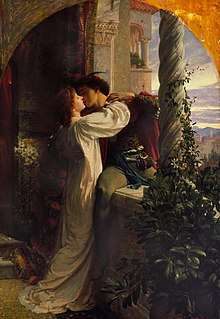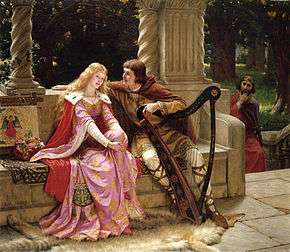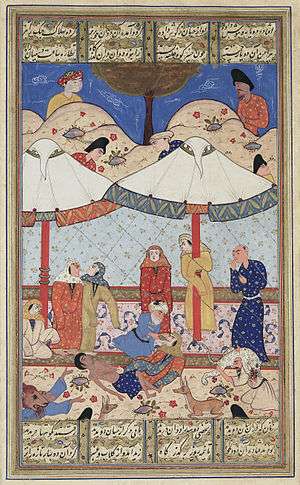Star-crossed
"Star-crossed" or "star-crossed lovers" is a phrase describing a pair of lovers whose relationship is often thwarted by outside forces. The term encompasses other meanings, but originally means the pairing is being "thwarted by a malign star" or that the stars are working against the relationship.[1] Astrological in origin, the phrase stems from the belief that the positions of the stars ruled over people's fates, and is best known from the play Romeo and Juliet by the Elizabethan playwright William Shakespeare. Such pairings are often said to be doomed from the start.

Definitions
The phrase was coined in the prologue of Shakespeare's Romeo and Juliet:
From forth the fatal loins of these two foes,
A pair of star-cross'd lovers take their life (5–6).[2]
It also refers to destiny and the inevitability of the two characters' paths crossing. It usually but not always refers to unlucky outcomes, since Romeo and Juliet's affair ended tragically. Further, it connotes that the lovers entered into their union without sufficient forethought or preparation; that the lovers may not have had adequate knowledge of each other or that they were not thinking rationally.[1]
(The original texts of the prologue, Q1 and Q2, use the spelling "starre-crost", but the version "star-cross'd" is normally used in modern versions.)
Classical examples
Examples of famous star-crossed lovers vary in written work. Pyramus and Thisbe are usually regarded as the source for Romeo and Juliet,[3] and is featured in A Midsummer Night's Dream. Wuthering Heights, considered to be one of the greatest love stories in literary works,[4] is a tale of all-encompassing and passionate, yet thwarted, love between the star-crossed Catherine Earnshaw and Heathcliff, and how this unresolved passion eventually destroys them and many around them.
In Virgil's Aeneid, the Trojan exile prince Aeneas and Dido, queen of Carthage, fall passionately in love – but the gods order Aeneas away and the spurned Dido commits suicide. Of course, Virgil's readers in First Century Rome could know in advance that this love was doomed, since Aeneas' and Dido's progeny – respectively the Romans and the Carthagenians – would eventually become mortal enemies.
Lancelot, a trusted knight of King Arthur's Round Table, and Guinevere, the queen of Camelot and wife of Arthur, were involved in a star-crossed affair. In some versions of the tale, she is instantly smitten, and when they consummate their adulterous passion, it is an act which paves the way for the fall of Camelot and Arthur's death.
The legend of Tristan and Iseult (also known as Tristan and Isolde) is an influential romance and tragedy, retold in numerous sources with as many variations. The tragic story is of the adulterous love between the lovers. The narrative predates and most likely influenced the Arthurian romance of Lancelot and Guinevere, and has had a substantial impact on Western art and literature since it first appeared in the 12th century. While the details of the story differ from one author to another, the overall plot structure remains much the same.
Pedro of Portugal and Inês de Castro shared a true and tragic love in the Portuguese 14th century. The dramatic circumstances of their relationship, forbidden by Peter's father, King Afonso IV, Inês' murder at the orders of Afonso, Peter's bloody revenge on her killers and the legend of the coronation of her exhumed corpse by Peter, have turned their story into a frequent subject of art, music, and drama through the ages.
Hero and Leander is a Greek myth, relating the story of Hero (Greek: Ἡρώ), a priestess of Aphrodite who dwelt in a tower in Sestos, at the edge of the Hellespont, and Leander (Greek: Λέανδρος, Leandros), a young man from Abydos on the other side of the strait. Leander fell in love with Hero and would swim every night across the Hellespont to be with her. Hero would light a lamp at the top of her tower to guide his way.
Pelléas and Mélisande (French: Pelléas et Mélisande) is a Symbolist play by Maurice Maeterlinck about the forbidden, doomed love of the title characters. A classical myth, was a common subject for art during the Renaissance and Baroque eras.
Troilus and Cressida is a tragedy by Shakespeare, believed to have been written in 1602. The play (also described as one of Shakespeare's problem plays) is not a conventional tragedy, since its protagonist (Troilus) does not die.[5] The play ends instead on a very bleak note with the death of the noble Trojan Hector and destruction of the love between Troilus and Cressida.[5]
Venus and Adonis is a classical myth during the Renaissance. Heer Ranjha is one of the four popular tragic romances of the Punjab.

Popocatépetl and Iztaccíhuatl refers to a number of mythical and folkloric explanations of the origins of the volcanoes Popocatépetl ("the Smoking Mountain") and Iztaccíhuatl ("white woman" in Nahuatl, sometimes called the Mujer Dormida "sleeping woman" in Spanish)[6] which overlook the Valley of Mexico.
Layla and Majnun (by the Persian poet Nizami Ganjavi) is a classical Arabian love story. It is based on the real story of a young man called Qays ibn al-Mulawwah from the northern Arabian Peninsula,[7] in the Umayyad era during the 7th century. There were two Arabic versions of the story at the time.[8] In one version, he spent his youth together with Layla, tending their flocks. In the other version, upon seeing Layla he fell passionately in love with her. In both versions, however, he went mad when her father prevented him from marrying her; for that reason he came to be called Majnun Layla, which means "Driven mad by Layla". To him were attributed a variety of incredibly passionate romantic Arabic poems, considered among the foremost examples of the Udhari school.
The Butterfly Lovers is a Chinese legend about the tragic romance between two lovers, Liang Shanbo and Zhu Yingtai. The legend is sometimes regarded as the Chinese equivalent to Romeo and Juliet.[9][10]
Other classic star-crossed lovers include Devdas and Paro (Parvati) in Devdas, Paris of Troy and Helen of Sparta in The Iliad, Oedipus and Jocasta in Oedipus Rex, Mark Antony and Cleopatra during the time of the Roman Empire, Khosrow and Shirin during the time of Sassanid Persia, Heloise and Peter Abelard during the Middle Ages, and Emperor Jahangir and Anarkali, Cyrano and Roxane in Cyrano de Bergerac, Hagbard and Signy, and Maratha Peshwa (Prime Minister) Bajirao and Mastani during the peak of Maratha Empire.
See also
References
- Levenson (ed.), Jill L. (2000). Romeo and Juliet, The Oxford Shakespeare (Oxford World's Classics). Oxford: Oxford University Press. page 142 ISBN 0-19-281496-6.
- "Full text / script of the play Romeo and Juliet Act I by William Shakespeare". William-shakespeare.info. Retrieved 7 October 2017.
- Halio, Jay (1998). Romeo and Juliet: A Guide to the Play. Westport: Greenwood Press. p. 93. ISBN 0-313-30089-5.
- Wainwright, Martin (2007-08-10). "Emily Brontë hits the heights in poll to find greatest love story". guardian.co.uk. London. Retrieved 2007-09-12.
- Oates, Joyce Carol (1966/1967). The Tragedy of Existence: Shakespeare's Troilus and Cressida. Originally published as two separate essays, in Philological Quarterly, Spring 1967, and Shakespeare Quarterly, Spring 1966.
- Secor, R.J. Mexico's Volcanoes: A Climbing Guide
- ""Follow Your Heart: The Story of Layla and Majnun" by J. T. Coker". Theosophy-nw.org. Retrieved 7 October 2017.
- "Layli and Madjnun in Arabic literature". Artarena.force9.co.uk. Retrieved 7 October 2017.
- Dai, Fan (14 February 2000). "Butterfly Lovers: A Tale of the Chinese Romeo and Juliet". HOMA & SEKEY BOOKS. Retrieved 7 October 2017 – via Amazon.
- "[Guangzhou] Butterfly Lovers Violin Concerto (Mar 31) - Arts & Artists - Culture & Education - Newsgd". Newsgd.com. Retrieved 7 October 2017.

